
Retrofit Coordinator Summit
Online Event, 20th April 2020
Retrofit Coordinator’s Questions Answered
Context and Purpose
Whilst the COVID-19 Pandemic overshadows everything, the energy efficiency sector remains in a transitionary period to adopting whole house retrofit. To date, over 350 built environment professionals have started or completed the Level 5 Diploma in Retrofit Coordination and Risk Management through The Retrofit Academy. This growing band of Retrofit Coordinators have a crucial role to play in leading the retrofit projects of the future. Whilst their qualification gives them the theoretical understanding required, putting this into practical effect can be challenging in a period of uncertainty. This event gave Retrofit Coordinators the chance to put their questions direct to a panel of experts comprising:

Facilitator: David Pierpoint, CEO, The Retrofit Academy CIC
Section 1: Implementing PAS2030 (2019) and PAS2035
Why was PAS 2035 needed? Do we really need to do this on single measures like boiler replacements and loft installs?
Peter Rickaby: It flows out of the Each Home Counts Review (EHC). The objective was to restore confidence in the retrofit industry following several very high profile failures. Coming out of Each Home Counts came the idea of new technical standards, designed to restore the confidence of the public, government, and funding organisations. They have plenty of money to spend but have previously seen it as too big a risk to lend into whilst things were going wrong.
What are the government, BSI and TrustMark intending to achieve with PAS2035? What are the timescales?
Phil Mason: It is about trying to bring a consistent approach to the delivery of retrofit. We have somewhere in the region of 24 million properties that will require some degree of retrofit if we are to deliver net zero carbon targets by 2050. We need a consistent, recognised approach. We don’t want to get too far down the road of retrofitting at scale only to realise the retrofit process was non-existent or flawed. Now we need to put a good process in to practice – I realise there are concerns about this, but we will be able to respond and adapt over the next 12 months or so.
All jobs delivered under the TrustMark-banner must be PAS-compliant by the end of June 2021.
How does this relate to the Energy Company Obligation? Why is it being introduced into the ECO sector first?
Andrej Miller: Being a Trustmark registered business is a requirement of ECO as of 31st January 2020. We have trailed the fact that the PAS would be a requirement under ECO ever since the PAS was produced in its current iteration in December 2018. What we have now is a period of people working under the PAS 2030 (2017) and the PAS 2030 (2019) standards – what we’re calling the transition period. As of 1st July, 20201, everyone installing under ECO will have to comply with those standards.
Why ECO? Fundamentally we have greater control. It’s harder to introduce new standards into privately funded projects. ECO projects are funded by all of us in so far as the costs go on our energy bills, and therefore there is a view that we need to have the best possible standards. Not least because it is focused on low income households and vulnerable people. To an extent it is also a testbed. First of all, we can quite easily put extra requirements into ECO an see how it works at a relatively large scale. From our perspective this is a first step. We shall see what policies will come forward but certainly we don’t see the introduction under ECO as the only step to implementing these standards.
How do PAS2030 and PAS 2035 interrelate? Why have some certification bodies, like CIGA, started to renew installers to PAS 2030 (2019) immediately, whereas others are not doing so yet?
Nigel Donoghue: In 2017 CIGA decided to become a certification body and try to lead the way in terms of best practice. We lobby for a fabric first approach.
Traditionally we have focused on the installation of single measures under a system-designer led approach. It has been underpinned by an BBA Certificate and a product testing regime. System Designers have been reliant upon training and carding operating to minimum technical competences, with independent monitoring. We’re now moving to a focus on CWI or any other insulation measure on their impact on the property as a whole and how they interact with other measures.
Now we’ve gone down the NVQ route under PAS2030 to demonstrate competence, we are now training operatives not only about their own specialist measures but also the impact this measure will have on the wider context. We are developing new National Occupational Standards around this.
Why have we decided to go to PAS 2030 (2019) now? Partly by choice and partly due to the audit cycle for UKAS. We are not naive enough to believe everybody is ready. Some of the NVQs do not yet exist. Likewise, not all installers have qualified Retrofit Coordinators yet. We have dispensation to allow our clients special dispensation for 12 weeks to revisit these areas. I want our industry to be fully-prepared for the transition and our organisation to be at the leading edge – hence the position we are in now of being one of the first certification bodies to operate to the 2019 Standard.
Is Covid-19 likely to delay the timescales for Install companies to be accredited? Michael Sweeney, Union Technical
Nigel Donoghue: We have been having conversations with BEIS around this. It is going to have an impact as we move to having a fully qualified workforce. There is a backlog in having accredited Retrofit Coordinators. We have to work with it, so we have had some concessions from TrustMark. One being around the lodgement of jobs that were pre-notified and pre-assessed prior to transition. That provides some breathing space – it gives us sixty days from the date of notification of 30th April.
We are discussing with Andre how we can come up with practical works with UKAS in terms of how we assess somebody who has been ready. I am still of the view that we have to certification bodies who should have the plan for that migration strategy. We should be working with the installer companies and guiding them in terms of what it’s going to take to comply. We can’t let it drift.
Phil Mason: If we go back to the 60 days, if there’s work already in the pipeline that has been carried out under PAS 2030 (2017), and then is transitioned to the 2019 version where PAS 2035 kicks in, it causes an installer a difficulty in that he has to go back and realign the jobs they have already done. If we take that as an example of practical common-sense that can be applied, I think that’s a good example. We’ve agreed to review the 60-day period with BEIS and UKAS. It’s not about kicking PAS 2035 down the road because we can’t afford to do that. But we do have react pragmatically. There’s no plan to delay timescales as we sit here today, but that is a decision we will have to keep under review as the crisis unfolds.
What we don’t want to do is to lose businesses, but we do have to stay true to the principles and timescales that have been set out.
Andrej Miller: we think the new standards are absolutely the right way to go and we have no plans to change the requirements for ECO. The transition period will be until 1st July next year. However, within that, we will consider whether there are further flexibilities it is appropriate to introduce. It is hard to tell where we will be in 2-3 months’ time. We will have to take stock of how many Coordinators there are, how people are progressing, recognising that whilst there is a hiatus, it makes it difficult to learn from how the Standards are employed.
Will retrofit coordinators have to bear the brunt of any future insurance claims if a contractor substitutes materials in the course of a build? Alex Hunt, Bright Green Homes
Peter Rickaby: There is a provision in PAS2035 that says that substitutions cannot be made without the Retrofit Coordinator’s approval. If the installer wants to change something, they have to go back through the process to the RC, who may need to go back to the designer. If that process is applied, as far as I can see the Coordinator is doing their job. If they make the wrong decision, they’ll be accountable. But if a contractor makes an unauthorised substitution, it is the contractor who would be liable.
Phil Mason: I always think there is a parallel with a LABC officer. If something happens behind the scenes that he couldn’t possibly know about, it seems unfair to lumber that on the RC. If a contract is put in place with a good supply chain beneath the RC, and good compliance processes and monitoring, it negates the chances of these things happening. There is a possibility that an unscrupulous contractor without an RC knowing before they can’t be there every minute of every day. It throws up the need for good compliance and management of projects with suitable contracts in place that define responsibilities and working on good relationships.
Are there any guidelines on what level of Public Liability Insurance a Coordinator should carry? Does the insurance industry understand what a Retrofit Coordinator does? Vincent Brissenden
Nigel Donoghue: The insurance industry doesn’t know what a RC is, and I think there is some work to do about how it is presented to them. It is an area that insurance companies have struggled with in the past, especially in terms of PI. Clearly people are setting up RC services, so it must be possible to obtain cover. We require PI cover at £5m but suspect it needs to be up to £10m.
Phil Mason: Clearly, we have got some work to do. Should there be an invite to elements of the insurance industry to the PAS 2035 Steering Group, to open their eyes to the role? Collectively as an industry we need to engage with them to help with their understanding.
Peter Rickaby: the insurance industry tends to price things high when they are new. But the whole dilemma is that this whole new PAS2035 process should be de-risked. We should be able to convince the (insurance) industry that this a good thing for them and not something they need to load premiums for.
As a qualified RC, can you provide evaluation services to other RC’s as part of the monitoring and evaluation process?
Peter Rickaby: yes. No problem at all provided you have the Level 5 qualification. BSI has scoped and is currently funding a new Standard called Building Performance Evaluation, which will cover retrofit but also non-domestic and new build. It will take a couple of years to happen. As part of that of that Standard we will be specifying qualifications for Evaluators, and we will then be in a position to adopt those in a future edition of PAS2035. But it’s going to be a couple of years down the line.
Can the retrofit coordinator also be the designer if correctly qualified? Can a retrofit designer being a member of CIOB carry our design work on all low, medium & high-risk measures? Brian Mckevitt, Energy Saving Installers LTD
Peter Rickaby: the answers is again yes, provided he meets the qualification Annex A of the PAS. There’s no reason why the Coordinator can’t be the designer. The idea for the Retrofit Coordinator came from the RIBA originally as a new role in retrofit for architects.
Phil Mason: we tried to map the risk pathways and put the qualifications against the paths in a tabulated format– this is posted on the TrustMark website called PAS2035 Roles and Qualifications.
David Pierpoint: This seems to be a big issue, so I think we’ll undertake to go away and do some proper work on this and come back with a coherent response.
Do we have to carry out an air tightness test on every property with a medium or high-risk measure installed? Brian Mckevitt, Energy Saving Installers LTD
Peter Rickaby: the answer is no. The only requirement for an air pressure test is in Risk Pathway C. I think there is a recommendation that you should consider it in B, but you don’t have to do it.
As a housing association, will this (WHR/PAS2035?) affect our ability to obtain funding via ECO3 or other for retrofit projects?
Andrej Miller: from an ECO perspective, it shouldn’t restrict you. It may be that there are higher costs associated with meeting the new standards, and that’s what we expected. We accept that there may be situations where we accept that during the transitionary period there may be some disadvantages of working to the new standard. We have tried at least to offset that with the uplift available during this before until 1st July 2021. As a supplier you get more for your money – a 20% uplift on your ECO scores. We would anticipate this would feed through to the supply chain. There shouldn’t an issue on the ECO side. On other aspects there is likely to be a greater cost to implementing the new Standards, but it is up to you to consider what the benefits to that are. We come up against difficulty evaluating the benefits of this approach because when we do a Cost Benefit analysis of retrofit, we assume that everything is done as it should be. To some degree these new standards are just making doubly sure that people are doing what they probably should have been doing before. We can certainly look at past failures, what the costs are of putting things right. We’d encourage housing associations to their own Cost Benefit analysis.
Nigel Donoghue: for those working under ECO, there is a considerable cost involved in meeting the new standards. We need to make sure that government keeps its promises around whole house retrofit because if it allows a lesser market to emerge, we have failed. It’s crucial that the Standards are supported across all sectors. Therefore, housing associations should not just take the funding on offer but should see it in the context of whole house retrofit.
Should funding be obtained via ECO3 or other, can this work be procured and managed in house (housing association) with an RC overseeing the project?
Is there a real danger that this whole endeavour, that is now around 5 ½ years in the making, that we’re now going to be left a tick-box exercise as the tangible outcome?
Phil Mason: I think we have got
to be very careful that that’s not where we end up. If we do, the benefits of
the PAS will not translate into the work that is carried out. We have a number
of Coordinator schemes – still in their infancy – our role is one of education
and encouragement, working closely with those schemes to ensure there is
consistency across the schemes and working to one common standard. My fear is
that if it goes unchecked, we’ll lose the benefits and I think there is a big
responsibility upon Trustmark. We need to clear with those schemes and if we sense
that somebody is struggling, we will be there to help. If Standards are
starting to slip, and we had a weaker scheme, the temptation for less
scrupulous individuals will be to go to that scheme and we can’t allow that to
happen. It is a once in a lifetime opportunity to deliver something that works
and makes a difference.
Coordinator Polls – PAS 2030 and PAS 2035
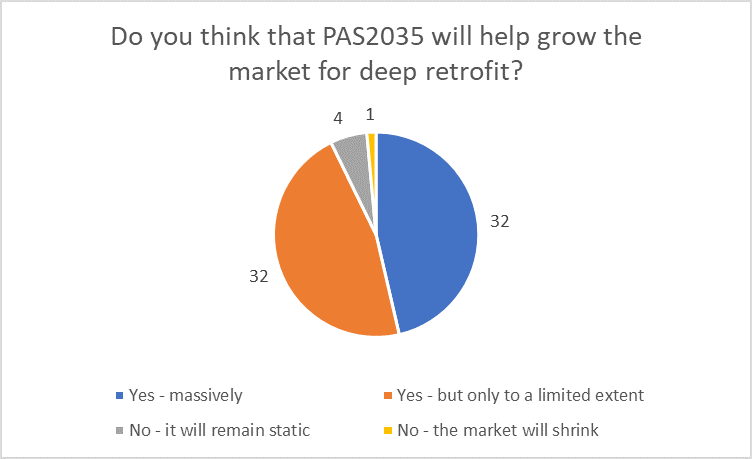
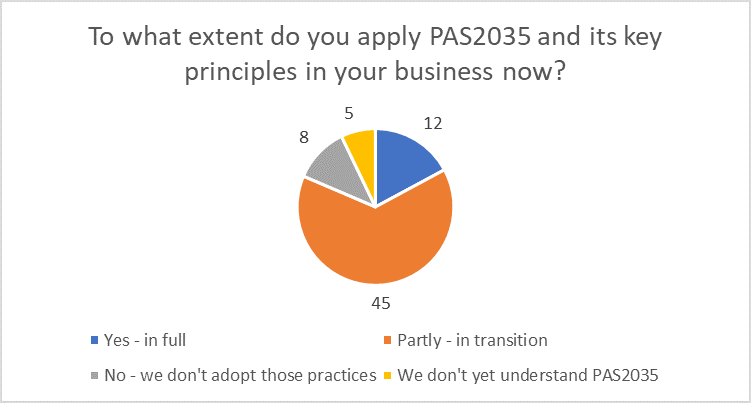
Andrej Miller: this is really encouraging and very positive. We need to carry on and it needs to expand because the opportunities are huge. We need to insulate all these homes but there are going to be very difficult decisions for politicians over the next 5-10 years. The COVID-19 situation will make that harder. But we will need policies and those decisions are made more difficult if they see that 10% of all retrofit fails to the extent that people’s health is put at risk. They will not be able to put massive schemes in place unless they can trust that people won’t be put in danger. Even without the political aspect, the positive side of things is that the if the finance industry trusts that this is working, they are much more likely to come in and help solve the problem through low-cost finance. I recognise there are difficulties, but I think it is essential that this goes forward.
Section 2: Technical Excellence and Best Practice
PAS2035 is often said to herald the dawn of whole house retrofit. What is WHR?
There lots of confusion about it. WHR does not mean everything at once – there are still some people at BEIS who think it does. WHR means having a plan for a house to get to a carbon neutral position by 2050. As opposed to what we’ve done in the past, where we have chased the money. Where an energy company says we have ECO money for EWI, and therefore that being what you get. It’s about creating a plan and setting off in the right direction. WHR is about having a whole house assessment, a plan for 2050 and a list of measures in the correct sequence that can be applied.
In terms of technical best practice, what are the primary elements of WHR that are different from current approaches?
ND: At the moment, if you look at systemised approaches like EWI and CWI, we look at specific system designs. You need to consider what impact what you might do will have what’s happened before and what may come in the future.
Which so you think is better. A step by step retrofit or all at one time? Declan Daly, Tipperary Energy Agency
PR: A few people already do very deep retrofit – but it’s very expensive and there are few householders or landlords who can afford to do it. If we can’t, having a plan to do it step-by-step rather than randomly is definitely the second-best approach. That’s what we’ve tried to do with PAS 2035 – have a plan and implement it when you can, when you can afford it.
How can we check if our medium term retrofit plans are acceptable? Alex Woodcraft, EcoAlex
Phil Mason: we are working with our Scheme Providers. Currently lodgement to the Data Warehouse can be made directly by the registered Retrofit Coordinator. We’ve started to dip into those that are coming in – we were receiving hundreds before the COVID outbreak. We sample these and refer them back to the Schemes, who should feedback to their member accordingly. In some instances, we’ve seen some good things, in others we’ve seen some things that are incomplete. The key to this is to see your Coordinator Registration Scheme as somebody who is there to support you and develop Standards with you. For me, it’s about talking to them, tracking some trends and seeing if there are things that can be made more straight-forward. There is a noticeable will from the Schemes to not just be a registration scheme, but to help Coordinators develop and grow.
Where can a Retrofit Coordinator go to find technical advice and support? Ruxandra Palcu, Retrofit Coordinator
PM: I think there is a responsibility on Trustmark to ensure our schemes are operating consistently in terms of content and quality. Something that’s started to spring from this is that there is a PAS Integrity Group that is starting to track the progress of industry. Members of that Group have an obligation to look at questions like this and see how we can feed technical best practice back into the industry.
Is there a Sample Medium Term Plan? Roy Rogers, LMF Services Ltd
PR: The contents of the MTRP are simple and are set out in Section 2 of the PAS. Whether that is a good plan is another question. A number of groups are trying to help Trustmark out by developing examples. I think we are getting closer and when we have a good one, we should be sharing it online.
Template Designs would be a good idea – are there any resources available?
There is a Retrofit Pattern Book, which was developed by Charlie Baker and colleagues. It’s an excellent resource in which Charlie has uploaded all the details they have generated. Others have already agreed to populate that, and we’d urge other Retrofit Coordinators to do the same so that we don’t have to reinvent the wheel every time.
What are your opinions on new floor insulation and whether floor joist rot is an issue with it? Natasha Ginks, Renovate Green
PAR: I help to run the UK Centre for Moisture in Buildings at UCL. Suspended Timber Floors are high risk elements of the building, especially for moisture management. The Standard only asks us to manage moisture risk in a sensible way. We deal with joist ends and condensation risks in the course. There are advantages and disadvantages to all methods. I think of doing the floor a bit like doing the external wall insulation – we avoided it for a long time because it is risky, disruptive and expensive.
ND: We’ve just completed some Best Practice Guidance for BEIS. Q-Bot is the only approved underfloor system approved at the minute. However, the guidance isn’t about specific systems. The aim of the report and the work on National Occupational Standards is to improve judgment. This covers the whole process, from the design and assessment phase right the way through to the installation and beyond.
AM: We aim to publish that guidance document within the next 2-3 weeks.
How can you judge whether mechanical ventilation is essential when EWI or IWI is installed? Natasha Ginks, Renovate Green
There are very clear criteria in PAS2035 about when you must go to continuous ventilation rather than intermittent. There are also criteria in Part F and Part L1B of the building regs. It’s mostly around the airtightness of the envelope. If there is a risk that the airtightness will dip below 5 cubic m2/per hour at 50 pascals, you need to move to continuous (mechanical) ventilation.
Lots of installers offer a small range of measures. What do they do when a MTRP says that the measures they install are not the necessarily the best place to start?
PAR: The Plan is agreed by the Coordinator with the client and should reflect their wishes. It would be a brave Coordinator who went against their wishes.
Whole House Retrofit Polls

The norm by 2021? – 12% yes, 75% say in part, 13% say it will be business as usual.
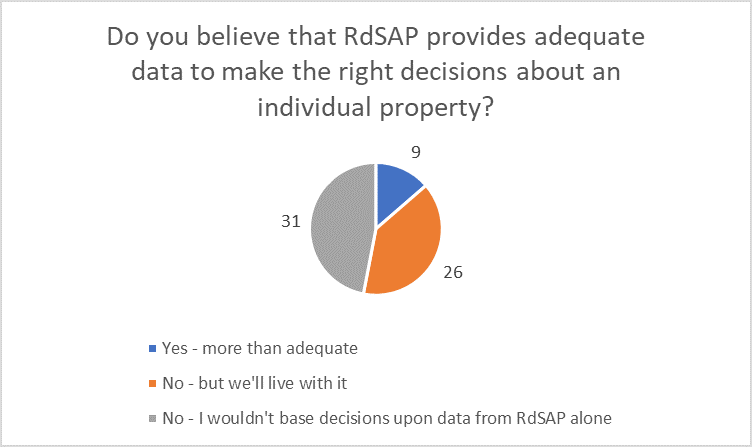
RdSAP – almost half saying they wouldn’t use RdSAP alone to make decisions. 39% saying it’s not ideal but we’ll live with it.
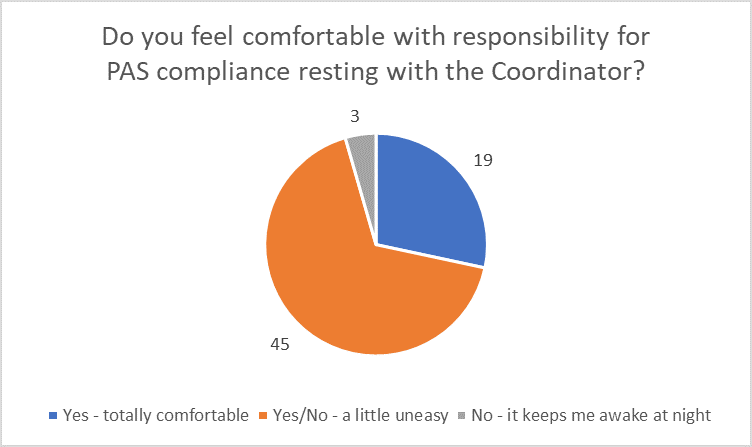
67% of Coordinators saying they are to an extent uneasy with it being their signature signing off on a project. Lack of confidence? PR: “It’s the house that complies, not the Retrofit Coordinator. What the RC does is assemble the evidence that it does comply, and Trustmark assesses that evidence. It’s not completely down the to the Coordinator. They need to make sure that other members of the team have done what they are supposed to do.”
PR: The Assessment required by PAS2035 is a lot more comprehensive more than the standard energy efficiency assessment currently carried out as standard. A PAS2035 Assessment includes the context, condition, the energy performance and the ventilation of the dwelling, and all of those together are what the decisions are made on. A lot of the PAS 2035 Steering Group were unhappy about using RdSAP, and that’s why we also included and encouraged Coordinators to use full SAP or PHPP. A lot of the industry use RdSAP and there would be great practical difficulty in banning its use straight-away.
ND: if we get anything out of this – and this is why we need the consistency across the market as a whole – we have got to move away from a funding regime that means that somebody does a relatively insignificant measure because it’s more profitable. We have got to do the right measure for the right property. We need to be fabric first, get the fabric right and then build on that.
Section 3: The ECO and The Future Market for Whole House Retrofit
What do the government think ECO 4 might look like? Will it be a whole house retrofit strategy?
AM: We don’t know anything for certain. What I can say is that ultimately this is up to Ministers. From my perspective I am clear that it would rash to change direction, to move away from WHR. We are committed to moving away from a single measure approach. PAS2035 doesn’t mean you have to all the measures in one go. But we certainly want to move to scenario where a one-off, deep intervention is possible. We want to take those homes up as high as possible up the efficiency scale. Simply there isn’t time not to – we have targets for 2030, 2035; we haven’t got time from the mid-2020s to revisit those homes multiple times. We have had that argument over the last 10 years – since ECO started. We have been able to argue that you might get innovation that reduces the price and therefore the price of a revisit might be exceeded by the cost saving of employing that innovation. But the argument has started to go away now. We are conscious that we must do measures in a more coordinated way, and more aware of the risks of not doing that. Future recommendations will be based on a multi-measure approach – whether for a small terrace or a large house. We’ll be looking at a scoring mechanism that incentivises people to go for large scale interventions. If we can, we should move to a system where we monitor and reward for actual in situ performance. That is going to be a big challenge but its certainly our ambition. As is supporting companies to innovate rather than just demonstrating compliance.
Can you get the 20% uplift available on things like solar PV and heat pumps given they are covered by the MCS, rather than the PAS, standards? Adrian Wright, Happy Energy
AM: I’ll have to check. If it’s not covered under the PAS, technically they may not be included. We’ll need to come back on this.
PAR: MCS projects are covered by PAS2035 but are not covered by PAS2030. The MCS Standards are an alternative at the installation phase under PAS2030 – they are not an alternative to the design stage under PAS2035.
Retrofit Co-ordinator services for portfolios or estates makes economic sense. How can we make it work for single owner occupiers?
PR: nearly everything that’s in PAS2035 came out of experience that want back to single dwellings. If there’s a lack of experience it’s of those doing it at scale. I would say there shouldn’t be a problem. It will put the price up, but it means you get a good job. One of the purposes of having PAS2035 was in giving the individual householder confidence. Remember that 68% of the 25 million houses we have to deal with are owner occupier, so this has to work for owner-occupiers.
Are finance providers now requiring PAS2035 as a condition of loans and mortgages. If not, when is this likely to happen?
PM: The answer is that it’s not a requirement now, although we talk to the Green Finance Institute and others and they are all very drawn to the fact. They are trying to work up green finance instruments, mortgages, and loans. What they are really attracted t is that collectively the finance industry is trying to move towards something that achieves something and is more than just green in name. What they are really attracted to – not all of them understand the full detail of PAS2035 – but there is now method reducing risk, which reduces the risk of default on payment. And that it’s being monitored for compliance. When will it happen? I can’t answer that, but we continuously bang the drum and they ae becoming increasingly comfortable about reducing risks. We are probably talking in terms of a year or more though, but it is on the way.
Significant problem with retrofit is to get reliable, accredited trades signed up. How is this progressing? Richard Frith, Assess Energy
Some roles in the process are in short supply or missing – what is happening to bring Designers and Evaluators to the table?
PR: we are training Retrofit Coordinators in some of the basic principles of evaluation. We are working on the BPE standard, which will lead to further training and qualifications. In terms of designers, the qualifications are largely professional qualifications so there’s no reason for them to be in short supply. They are not used to working in our sector though and lack experience.
PM: We are probably paying for under investment in the sector over the years. Historically, other trades are more attractive, and we are paying the price. It’s a big nut to crack. What’s happening now in terms of Covid19 and isn’t helping. But out of this may come an opportunity for companies to offer quality services in a quality sector. We all need to keep engaging with the industry around the benefits, raising the profile and reputation of the sector to attract others. People want to work in a sector they are proud of.
PR: Inconsistency in the policy area deters people from training or investing in the sector. If people saw a reliable workstream ahead of them, they would be far more likely to upskill. We need to be less stop/start.
How would I go about building a business around this opportunity?
PM: you have got to build your supply chain, your confidence in others. Your service offering is then greater. If you are just a Coordinator in isolation, you need to be working with a broad supply chain so that a WHR can be done in one go, you need to be able to offer the whole service. Including access to the trades that will allow you to do so.
How do you do that? The industry can help in terms of forums where introductions and networking forums for installers to understand each other. It’s about building their networks and their understanding of each other.
Is there a list of approved WHR contractors? Helen Rooney, Social Landlord
PM: in Trustmark are lists of individual trades – what we could possibly start to work on is how we can publish something informative for the industry and the consumer to take some of the issues away. A one-stop-shop type list is something that has been on our radar for a while. Lots of small sub-enquiries are hard to manage.
Polls – The Future Market
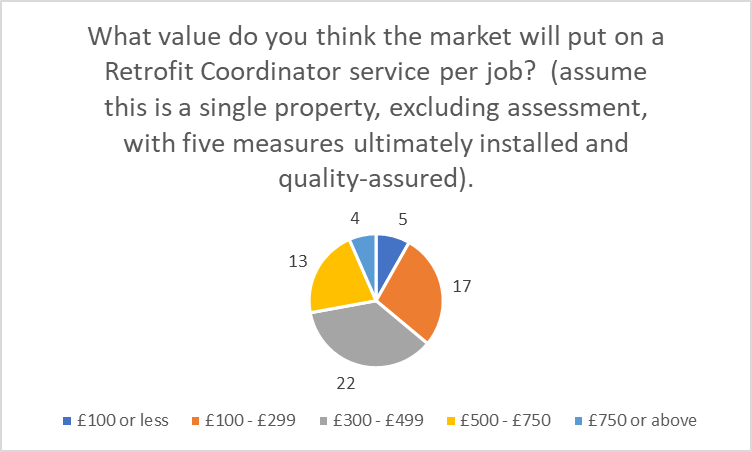
Coordinators expect the market values the service at an average of £300-499. 23% say between £500-750. Only 8% under £100.
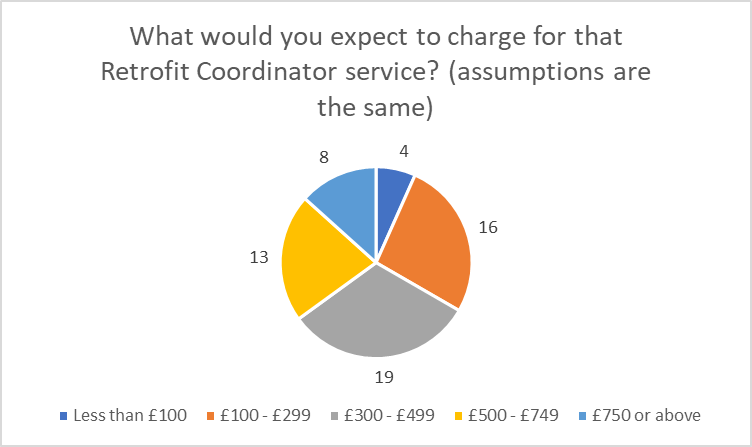
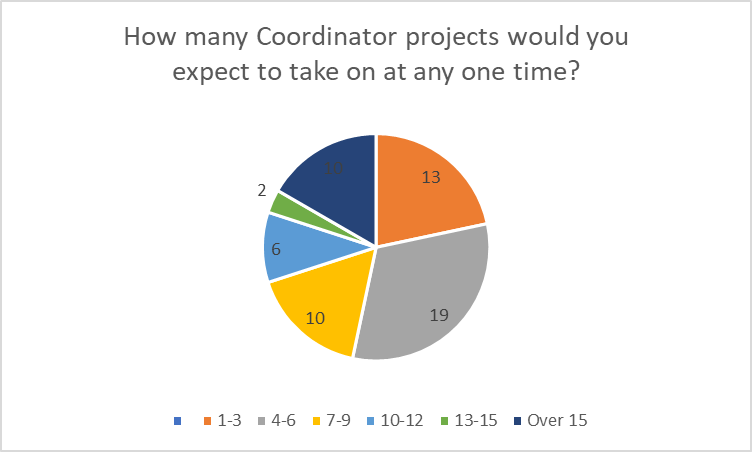
Average number of projects is 4-6, suggesting they feel there is a lot involved in each project. 15% saying over 15 projects at a time.
PM: The public will want to pay less and its important that the services are priced at a realistic level. We can not start a race to the bottom. We are finding a number of organisations working on digital tools that should help us to become more efficient, bringing down the time against the service. It should also allow Coordinators to take on more projects.
ND: the market will sort itself out ultimately. We’ll start off with what we think is an effective pricing point and then it will adjust over time. It’s incumbent on all of us to make sure that where there is a very low price point, and where people have developed good tools, that we police it properly. Where we’ve failed in the past is where the policemen have failed to police it effectively.
PM: Trustmark are very focused on what the outcomes are. It’s critical that high standards are maintained. Organisations should also reap the benefits of delivering high standards.
Will there still be a market and an industry sanding after Covid-19 has passed?
AM: What is the demographic of people who are claiming Universal Credit? It will expand the eligible pool even under the current ECO. If those people are predominantly young renters, they won’t benefit from ECO. In terms of whether there will be money available, even if it’s the same amount available as present, we would still recommend moving to a new approach. It’s not a requirement to have billions more for us to be persuaded that this approach is necessary. We would have to treat fewer homes, but that would nevertheless be the right approach. Obviously, the politics of what will happen over the next few years will be important to the decisions. Perhaps ministers won’t want to treat fewer homes? But from our perspective as advisors, that’s what we would put forwards.
ND: paradigms are changing. If we’re all going to work from home for a prolonged period of time, patterns of energy use will change. I don’t think the next generation will let us forget the climate crisis, and it’s important we think long-term. We cannot take our eye off net-zero 2050.
We will see an industry that will look different under ECO 4. The numbers of installers remaining in the sector is worrying. If we don’t grow the ECO market, we won’t have an industry. What we do now is really important to ensure we can deliver any of this – let alone whole house retrofit.
Would BEIS consider a national advertising campaign to build consumer awareness and confidence in our new supply chain? Julian Williams
AM. Tough one. Generally advertising campaigns are a big no-no within government. The Green Deal ad campaign overshadows what may be possible. That was the last time money was spent on promoting energy efficiency. There is a lot of scepticism over whether things like that work.
Will there a need to invest in green infrastructure as part of a stimulus package following COVID? Could domestic retrofit be part of a green ‘new deal’?
AM: I would love to think so. Government are thinking about what the new economy might look like – we are going to need a short-term stimulus to bounce out of this very deep slump. Domestic retrofit ticks a lot of these boxes. Net zero is being lined up. Many international commentators are saying this an opportunity to change the way we do things. Investment in retrofit spreads the benefits nationwide, as opposed to massive investment in nuclear. Many of the areas that will be hardest hit are already those who were lined up for ‘levelling up’, so there is definitely an opportunity. You could see a scenario where people have noticed what it’s like to be in their homes, because they are spending more of their life there. We will be putting forwards to ministers the reasons why domestic retrofit can help with social care, the NHS and independent living.
Could have a body to give Coordinators one voice moving forwards to help move the process forwards? Tim Freeman
ND: Having a body of people with some thoughts and ideas, but also experience of the limitations too, would be helpful. Government haven’t got a cupboard full of ideas and we need to continue to have a dialogue with those who may do. Particularly oven-ready ideas.
